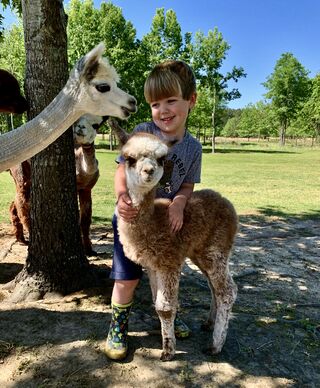10 Fast Facts about Alpacas
Friday, January 21, 2022
1. It has been estimated that alpacas are 30% more efficient grazers than sheep.
2. Alpacas come in 22 colors ranging from white, fawn, brown, grey and black.
3. Alpacas can live for up to 20 years, The oldest alpaca on record lived to be 27 years old.
4. They produce a highly sought after "Fleece". They product 5-10lbs of this "Fiber" "Fleece" per annual shearing
a. Alpaca fleece (wool) is naturally water repellent, hypoallergenic and difficult to ignite.
b. It is also warmer and softer than sheep’s wool
c. Next to mohair, alpaca fiber is considered to be the second strongest natural animal fiber
5. Incas first domesticated them over 6000 years ago. Their "Fleece" was reserved for Inca Royalty
a. Alpacas are native to countries in South America including Peru, northern Bolivia, Ecuador and Chile
6. They are great for the environment!? They are known as very efficient grazers.
a. Alpacas have soft pads on their feet, which don't churn up the ground like a cow or horse's hooves do.
b. When alpacas eat grass, they snip off the top of the plant unlike some other animals that pull the grass up by the
root when eating.
c. It only takes an acre of productive pasture to sustain as many as 8 alpacas. Alpaca only eats 2-lbs. per day
7. Alpaca mothers will always have their offspring in the morning.
a. By having their offspring in the morning, the offspring will have the whole day to dry off
8. Alpacas are known for using a communal Dung piles
a. This behavior allows "open" females of a specific "Herd" to broadcast estrogen levels to males in the local area
9. Alpacas are herbivores and they have a three chambered stomach.
a. They will mostly eat grass but some have been known to eat wood, bark, leaves and stems
b. They are not ruminants or pseudo-ruminants, but are true camillids
10. Alpaca fiber has unique properties
a. Fibers have millions of microscopic air pockets inside. Due to this, alpacas can retain body heat during cold days
b. Likewise, the skin of the animal can breathe through the hair during warm days






